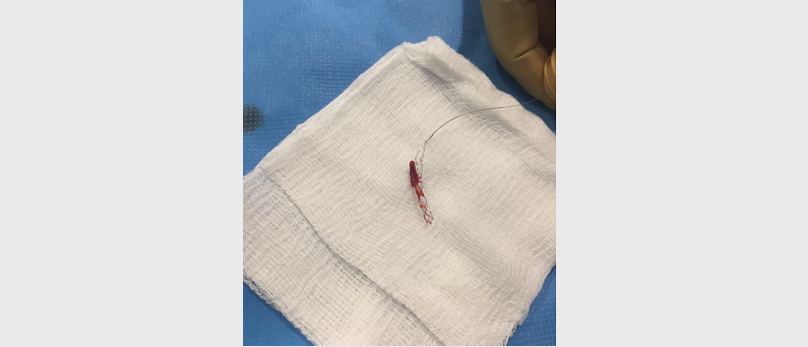Medical thrombectomy seems to offer the best outcomes in this subgroup, provided that it’s done by experienced operators and in the right patients.

Mechanical thrombectomy should be attempted among patients with large vessel occlusion strokes, even if symptoms are only minor, according to a new analysis of observational data.
Frank J. Veith, MD (NYU Langone Medical Center, New York, NY, and Cleveland Clinic, OH), who commented on the study for Neurovascular Exchange, called it a “minor game changer.” Even minor strokes, he said, can have catastrophic outcomes on patients’ health and quality of life, a reality that many interventionalists do not fully appreciate.
“Strokes are terrible, even when they’re minor,” he explained. “Every stroke changes a person, even when recovery is neurologically pretty good. . . . There is no such thing as a ‘minor’ stroke, in my opinion. From a patient’s point of view, they are all bad. Even if you can’t measure it, even if they are walking and talking, they are not the same person [anymore] in most cases.”
But for outcomes to be superior with mechanical thrombectomy in these cases, Veith stressed, it’s important that the treatment be performed by experienced hands and with appropriate specialized equipment and support.
Less Impairment, More Independence
For their paper published online last month in the Journal of NeuroInterventional Surgery, Diogo C. Haussen, MD (Grady Memorial Hospital, Emory University, Atlanta, GA), and colleagues retrospectively analyzed two large, prospectively collected datasets: STROPStroke and GESTOR. These registries compared outcomes of mechanical thrombectomy with medical therapy in patients with large vessel occlusion strokes.
The analysis included a total of 118 patients with minimal-symptom strokes occurring in the middle cerebral-M1/M2, intracranial carotid, anterior cerebral, or basilar artery. All had an admission NIHSS score ≤ 5 and a premorbid mRS score 0-2.
Overall, 88 patients were treated with medical management and 30 with thrombectomy. Multivariate analysis revealed that thrombectomy was the only predictor of a favorable NIHSS shift, independence at discharge, and independence at 3-6-month follow-up.
Outcomes of Thrombectomy vs Medical Therapy – Multivariate Analysis
|
|
Beta (95% CI) |
P Value |
|
Favorable NIHSS Shift |
-3.7 (-6.0 to -1.5) |
0.02 |
|
Independence at Discharge |
-21.9 (141.4 to 120.8) |
< 0.01 |
|
Independence at 3-6 Month Follow-up |
-21.1 (-39.1 to -19.7) |
< 0.01 |
In an analysis of 26 pairs of patients matched for age, baseline NIHSS, and IV tPA use, endovascular therapy was again associated with better outcomes, including a significantly lower NIHSS at discharge, a favorable NIHSS shift, and increased independence at discharge and 3-6-month follow-up.
‘Minor Game Changer’
To NVX, two of the study’s co-authors said they were unsurprised by the findings, given that they have shown similar results in the past. But it was important to confirm those findings, they said, in order to provide solid evidence for a shift in clinical care.
“The evidence for treating patients with low NIHSS is very limited, and physicians are less inclined to offer therapy in this scenario,” explained Haussen in a joint email prepared with senior author Raul G. Nogueira, MD (Grady Memorial Hospital, Emory University). “We have previously observed that a significant proportion of patients [with LVO strokes and minimal symptoms] have clinical deterioration, potentially due to collateral flow failure, and that nearly a quarter of patients were not independent at 90 days. The new findings involve a larger and different population, and corroborate the results of our previous study.”
Veith said that most patients with minimally symptomatic LVO strokes are typically treated conservatively. “The tendency in last the 2-3 years has been to see the value of the newer clot removing techniques for acute strokes, if done under the right circumstances,” he explained. “This study shows that if you take out the clot from an LVO promptly with the same techniques, even if symptoms are fairly mild, it leads to be better outcomes.”
While the study needs confirmation, “it should lead to more aggressive change in practice in institutions that are equipped and staffed to do it [correctly],” Veith predicted, adding, “In proper institutions, where they have proper skills and techniques and equipment, the current practice should change in that we should be more aggressive. As long the as patients are properly selected and have LVOs and minor symptoms, they should attempt to remove the clot.”
Haussen and Nogueira also emphasized the need for additional research. “We believe that further controlled studies are warranted to define the potential benefit of thrombectomy for patients with minimal symptoms and underlying large vessel occlusions,” they noted to NVX. “The field still needs to define the role of upfront intervention for these patients. It is not clear how many patients deteriorate, and what is the impact of the deterioration in their final outcome.”
Given the fact that collateral flow in these patients is typically excellent, they continued, their clinical needs may differ from those of patients whose strokes are associated with more pronounced symptoms. For instance, careful planning and execution of thrombectomy may be more important than speedy reperfusion. Some may even benefit from an observation period, with rescue reperfusion should they begin to deteriorate.
“The only way to definitively address these questions is through randomized controlled trials,” they concluded.
Source:
Haussen DC, Lima FO, Bouslama M, et al. Thrombectomy versus medical management for large vessel occlusion strokes with minimal symptoms: an analysis from STOPStroke and GESTOR cohorts. J NeuroInterv Surg. 2017;Epub ahead of print.
Disclosures:
- Haussen and Veith report no relevant conflicts of interest.
- Nogueira reports participating in clinical trials sponsored by Stryker-Neurovascular, Covidien, Core-Lab, and Penumbra.

